Choosing between Webflow and WordPress feels overwhelming—especially for Indian businesses balancing budget, speed, and long-term growth. When considering Webflow vs WordPress India, this guide cuts through the noise to help you decide confidently, whether you’re a startup, SMB, or scale-up. We’ll break down costs, performance, SEO, and real-world use cases—plus share our unbiased recommendations.

Quick Summary: When to Pick Which
Not sure where to start? Here’s a quick cheat sheet:
Choose Webflow If…
- You prioritize speed, security, and low maintenance (no plugin updates!).
- Your team includes marketers/founders who want to edit content visually (no coding needed).
- Your site is marketing-led (landing pages, frequent iterations, brand-driven design).
- You lack an in-house developer for ongoing fixes.
- You value predictable costs (hosting, CDN, and updates included).
Choose WordPress If…
- You need a massive plugin ecosystem for custom features (e-commerce, memberships, LMS).
- You have (or plan to hire) a developer for updates and integrations.
- You’re building content-heavy sites (blogs, news portals) with flexible editorial workflows.
- You require deep India-specific integrations (UPI, COD, GST invoicing).
Total Cost of Ownership in India
Cost isn’t just about the initial build—factor in hosting, licenses, and long-term maintenance. Here’s how they stack up:
Build Costs by Tier
| Budget Range | Webflow | WordPress |
|---|---|---|
| ₹5k–₹50k | Starter templates + minimal customization. Good for prototypes/temporary sites. | Lean themes + basic plugins. Ideal for simple business cards/brochures. |
| ₹50k–₹2L | Custom design + CMS + integrations. Includes hosting/CDN. | Custom theme + page builder + key plugins (e.g., WooCommerce). Hosted separately. |
| ₹2L–₹5L | Premium branding + animations + gated content + performance tuning. All-inclusive. | Complex custom features + enterprise plugins + dedicated hosting. Higher dev hours. |
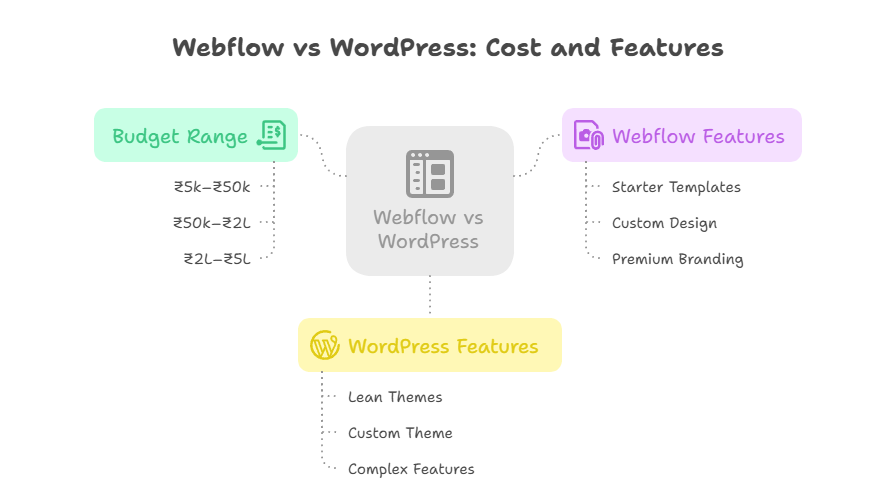
Hosting and Licenses
- Webflow: Predictable monthly/annual plans (₹1,500–₹15,000/month) that include hosting, CDN, SSL, backups, and automatic updates. No extra fees.
- WordPress: Separate costs:
- Hosting (shared: ₹500–₹2,000/month; VPS/cloud: ₹3,000–₹10,000/month).
- Theme/page builder licenses (₹2,000–₹20,000 one-time).
- Premium plugins (e.g., WooCommerce: ₹0–₹50,000+).
Maintenance and Unexpected Costs
- Webflow: Minimal. Automatic updates reduce “site break” risks. No developer time needed for patches.
- WordPress: Recurring updates (core, theme, plugins) + occasional conflicts (may require paid developer help: ₹1,000–₹5,000/hour).
Speed, Security, and Reliability
Performance impacts user experience and SEO. Here’s how they compare:
Core Web Vitals
- Webflow: Optimized out-of-the-box with global CDN and quality hosting. Most projects hit “green” scores faster (less effort required).
- WordPress: Can match Webflow with a lightweight theme, minimal plugins, server-side caching, and tuned hosting. But it demands more discipline.
Plugin Risks and Updates
- Webflow: No plugin sprawl = lower attack surface. Updates are automatic and seamless.
- WordPress: Power comes from plugins, but each adds bloat/vulnerabilities. Stick to reputable plugins and strict update routines.
Traffic Spikes and Scaling
- Webflow: Scales automatically for most SMB traffic (included in plans).
- WordPress: Depends on host quality. Choose a performance host (e.g., Kinsta, WP Engine) with CDN, autoscaling, and staging environments.
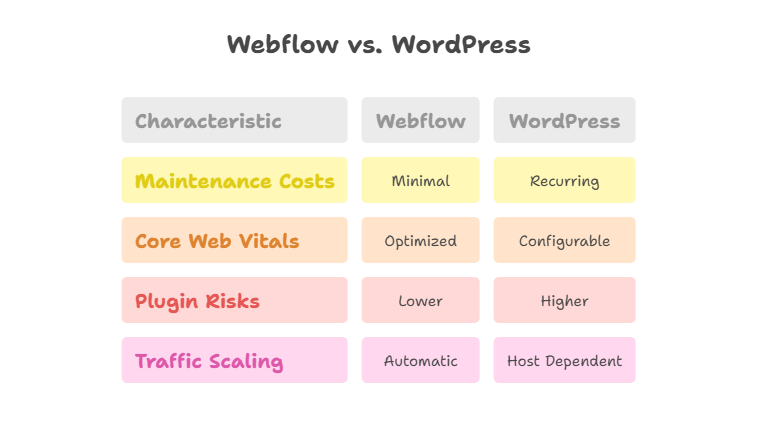
SEO, Content, and CMS Workflow
SEO success hinges on technical basics and content quality. Here’s how each platform handles it:
SEO Fundamentals
Both support clean URLs, meta tags, sitemaps, and 301 redirects.
- Webflow: Makes technical SEO easy (no plugins needed). Ideal for non-technical teams.
- WordPress: Granular control via SEO plugins (e.g., Yoast, Rank Math)—but configuration matters.
Editing Experience
- Webflow: Visual Editor + CMS lets marketers/founders update content without code. Perfect for iterative changes.
- WordPress: Gutenberg is improving, but many teams prefer page builders (e.g., Elementor) or custom blocks. Training/governance helps.
Localization and Multilingual
- Webflow: Native options are improving; third-party tools (e.g., Weglot) work well.
- WordPress: Mature multilingual plugins (e.g., WPML, Polylang) with robust features—but more setup required.
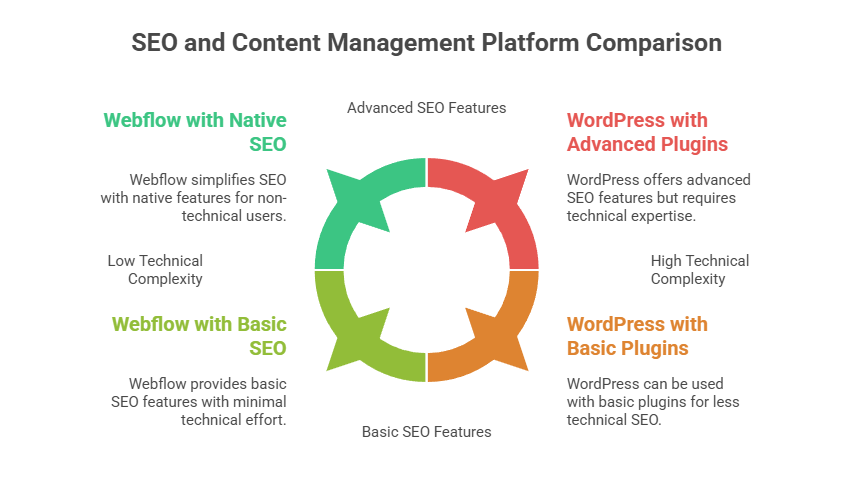
Ecommerce and Payments in India
For Indian businesses, payment flexibility (UPI, COD) and GST compliance are non-negotiable.
Payment Gateways
- Webflow Ecommerce: Supports major gateways (Stripe, PayPal). For UPI/wallets, use integrations (e.g., Razorpay) or third-party checkouts.
- WordPress (WooCommerce): Broad support for Indian gateways (Razorpay, PayU, Paytm, PhonePe) via plugins.
Checkout UX and Performance
- Webflow: Clean, modern checkout with fewer moving parts. Faster load times.
- WordPress: Highly customizable—but performance depends on theme/plugins. Optimize carefully!
Order Flows, COD, and GST
- WooCommerce: Established plugins for COD workflows, GST invoicing, and inclusive pricing.
- Webflow: May need workarounds for advanced India-specific logic (e.g., COD, GST).
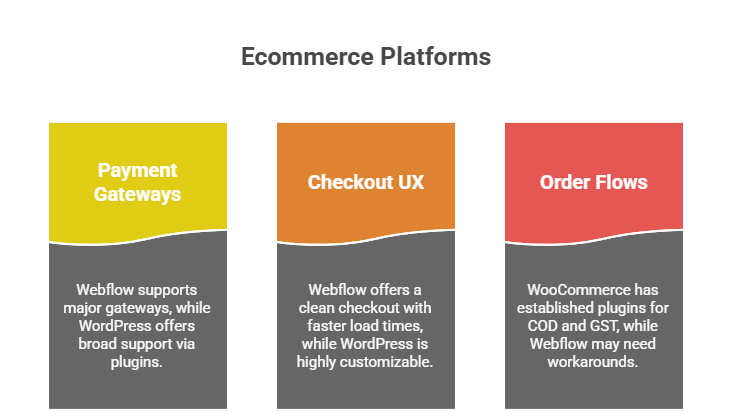
Use-Case Matrix: ERP, IT, Ecommerce, Blogs, Services
Match your business type to the best platform:
| Use Case | Webflow | WordPress |
|---|---|---|
| ERP/IT Product Sites | Shines for polished marketing sites + scalable components. Low maintenance. | Better for heavy custom post types/integrations—if you have dev support. |
| Ecommerce (D2C/Catalogs) | Great for brand-first stores with simple payments. | Winner for India: UPI, COD, GST, and plugin flexibility. |
| Blogs/Content Sites | Simpler to maintain. | Extreme flexibility for editorial workflows + advanced taxonomy. |
| Service Websites | Ideal for fast, elegant sites with forms/CRM. | Best for complex booking logic (e.g., appointments). |
Real-World Scenarios and Recommendations
Still unsure? Here’s how to choose based on your budget and stage:
Bare-Minimum Budget (₹5k–₹50k)
- WordPress: Use a lean theme (e.g., Astra) + minimal plugins. Get live fast—plan to upgrade later.
- Webflow: Limited to starter templates. Only recommended for prototypes.
Growing SMB (₹50k–₹2L)
- Webflow: Best for brand-forward marketing sites (speed + easy editing).
- WordPress: Choose if you need e-commerce (WooCommerce) or specific plugins—and can handle updates.
Scale-Up or VC-Backed (₹2L–₹5L)
- Webflow: Marketing-led, rapid iteration, low ops overhead.
- WordPress: Complex features, heavy integrations, content ops at scale—requires a performance-first build.
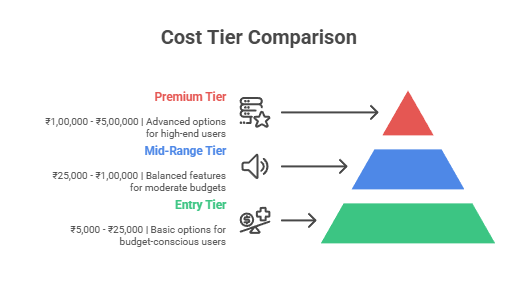
Migration, Handoff, and Team Ops
Switching platforms or working with designers? Here’s what to know:
Figma → Dev Handoff
- Both Webflow and WordPress support component-driven design systems. Use reusable sections/tokens for smooth translation.
Content Governance
- Set clear roles: Who edits? Who approves? Document workflows/naming conventions.
Security and Backups
- Webflow: Handles hosting security + automatic backups.
- WordPress: Enforce managed hosting + firewall/plugins (e.g., Wordfence) + automatic backups + staging for safe updates.
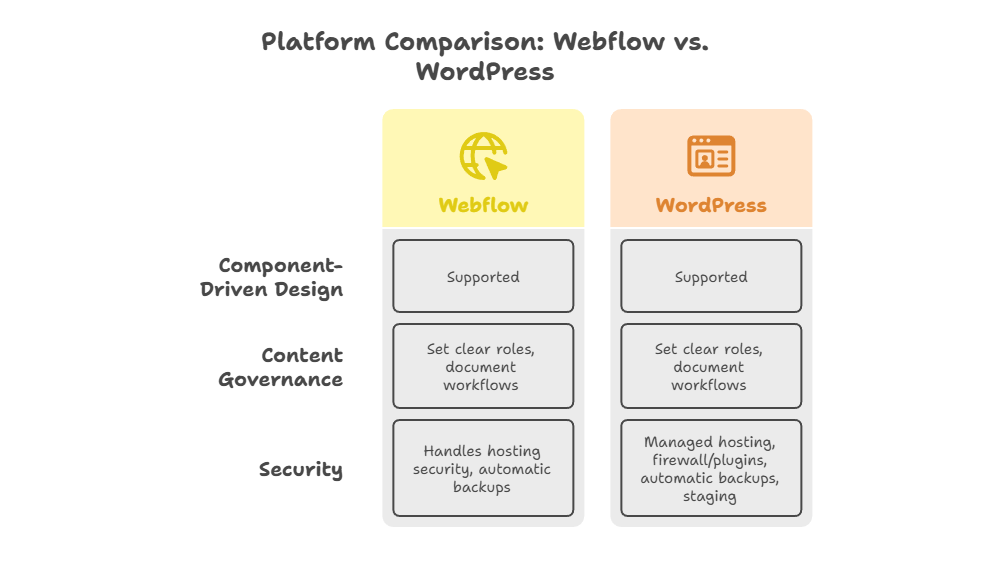
Frequently Asked Questions (FAQ)
Still have questions? We’ve got answers:
Q: Is Webflow good for SEO in India?
A: Yes! It covers technical basics out-of-the-box. Remember: Content quality and backlinks matter most.
Q: Can WordPress be as fast as Webflow?
A: Absolutely—with a lightweight theme, minimal plugins, solid hosting, caching, and careful build practices.
Q: Which is cheaper over 2 years?
A: Webflow has predictable costs + minimal maintenance. WordPress can be cheaper upfront but may require ongoing dev time. Total cost depends on complexity.
Q: Can I accept UPI?
A: WordPress (WooCommerce) supports UPI widely via gateways like Razorpay/PayU. Webflow may need a compatible gateway or alternative checkout.
Q: Which platform is better for ecommerce?
A: WordPress for India-specific payments/COD/GST. Webflow for simpler catalogs + faster design iteration.
What We Recommend
Not sure which fits your goals? Let us help:
- Marketing-led sites (speed, security, low maintenance): Webflow.
- Feature-heavy sites (ecommerce, memberships, complex integrations): WordPress (with a performance-first build).
Next Step: Ready to decide? Book a free 15-minute platform-fit call with us. We’ll recommend the best path for your business—no pressure, no jargon.
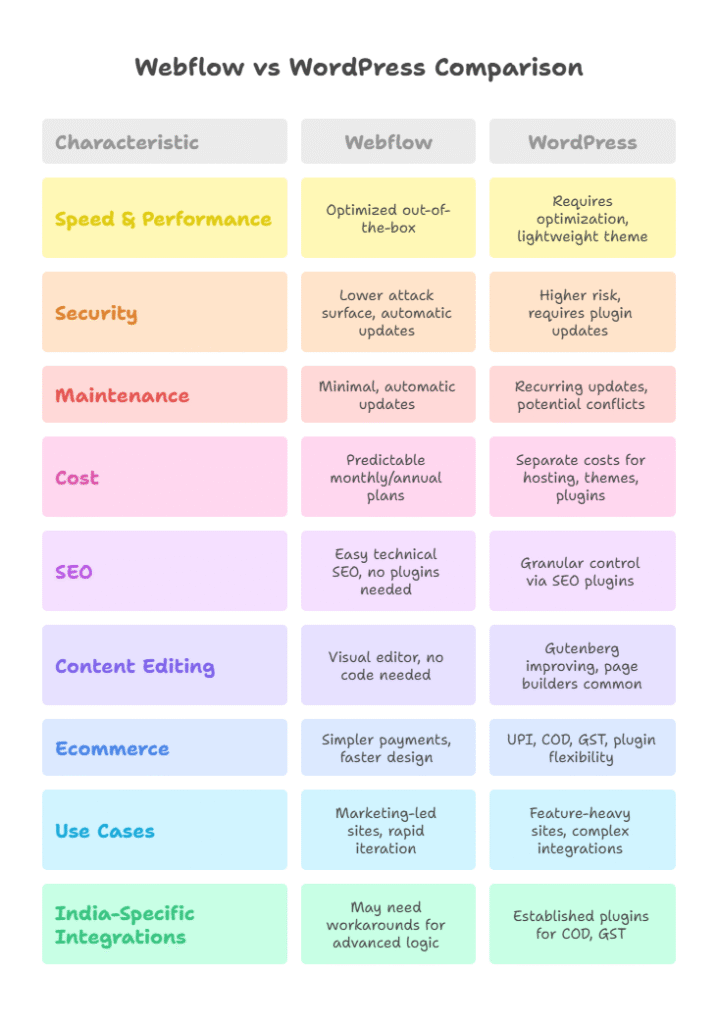
Download our Platform Fit Checklist (India Edition)—7 questions to clarify your goals, budget, and needs. CTA inside to book a call.